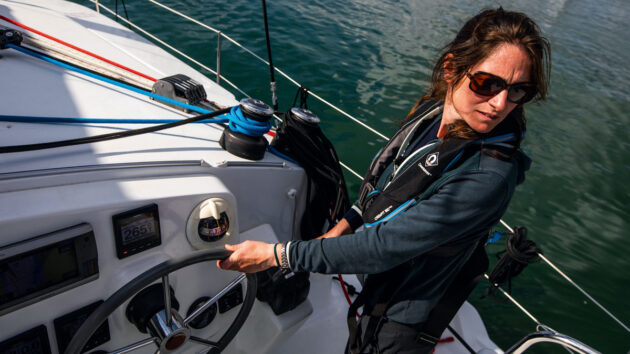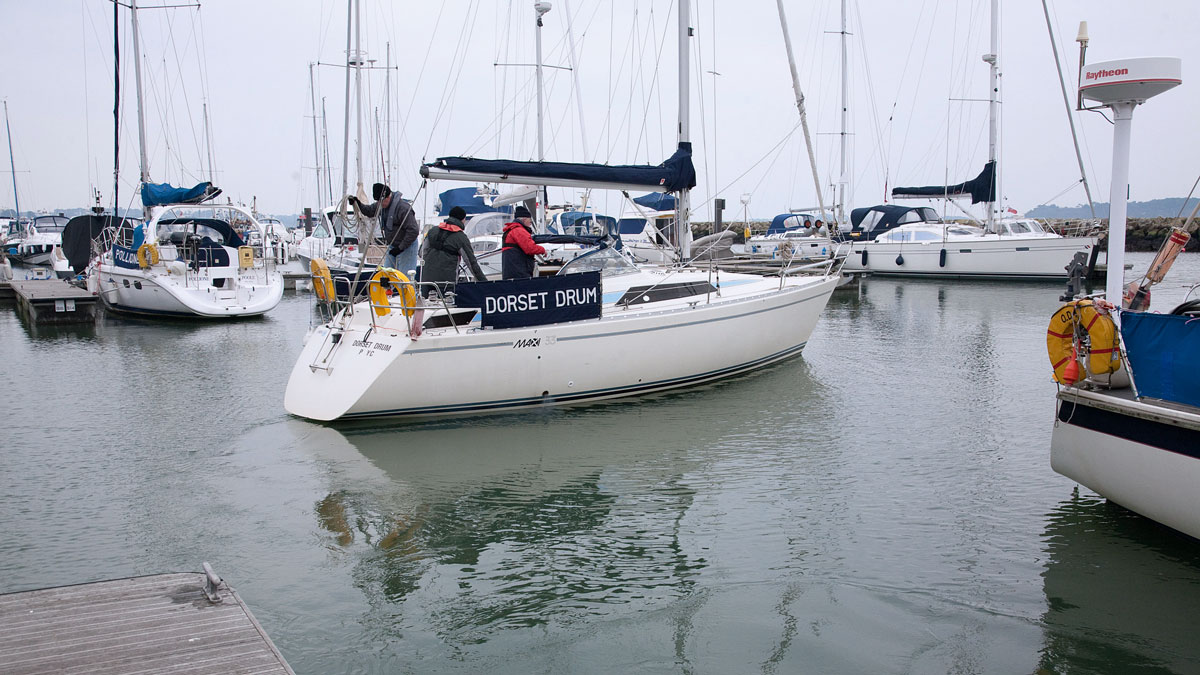Seasoned sailor Rupert Holmes shares his tips for better close-quarters manoeuvring under sail alone
It is amazing how quickly close-quarters manoeuvring under sail can go awry if there is a moment’s lapse of concentration, especially if you are new to sailing.
Here are my tips for staying in control.
1. Maintain balance between the sails:
Given a cruising boat with a roller headsail, it’s very tempting to pack the mainsail away and just use the headsail.
With the wind aft of the beam this is generally the best approach, but when the wind is forward of the beam power from the mainsail is invariably needed to maintain speed and steerage.
Don’t underestimate the importance of using the sails to help steer the boat, especially when travelling at slow speeds.
Powering up the mainsail will help you luff up towards the wind, while depowering the main and powering up the headsail will help you bear away.
2. Watch for gusts and wind shifts
Any confined space will have fluky winds, so it’s vital to keep an eye open all the time so that you’re prepared for each gust or hole.
It’s also worth bearing in mind that every change in wind strength is generally associated with a change in wind direction.
Spotting gusts is a big part of these sailors’ jobs – match racing is held on short courses close to shore so that spectators can see the action, but this of course means the wind is ultra-changeable.
It’s the crew that spots these changes in advance that always gains a big advantage.
Similarly, when manoeuvring in a confined space, the better you are at spotting gusts before they hit the easier it is, whether you’re under sail or under power.
A gust from well forward will tend to stop you and spin the bows downwind, so sheeting the mainsail in to gain a little extra speed just before it hits makes sense.
Equally, if you have mainsail set, watch for rogue gusts from on or aft of the beam that may give you more speed than you want – it’s worth having the halyard flaked out in advance and a crew member standing by so that it can be lowered instantly if necessary.
3. Maintain control of your speed
Ideally, aim for a fraction more speed than you need to reach your berth: this will keep you in control of the boat without the risk of slowing down so much that you lose steerage.
With the wind forward of the beam at least some power from the mainsail is needed, and enough boat speed to ensure there’s no danger of the water flow over the keel and rudder stalling.
With the wind well aft of the beam, the biggest worry is being able to stop in time – you’re not likely to lose steerage as the bow is already pointing downwind.

Partially hoist the mainsail to boost speed
To boost speed, partially hoist the mainsail and have a crew member hold the leech to act as the sheet.
If the wind is aft you can do the same with the jib – maybe partially unrolling the sail if it’s set on a furler.
But don’t try the jib alone with the wind on or forward of the beam: if you’re moving slowly the sail will drag the bow away from the wind, overriding the rudder in steering the boat.
Release the vang to depower the mainsail if the wind is only just forward of the beam.
The topping lift, or a gas kicker, can also be used to effectively depower the mainsail with the wind on the beam: by raising the boom, a considerable additional amount of power is lost from the sail.
This can be particularly helpful with fully battened mainsails as it’s more difficult to control the power in these: it tends to be either fully on or fully off, whereas a short battened sail can be powered up progressively.
Slow down using big, exaggerated helm movements.

Exaggerated helm movements will slow you down
Every sailor knows that making more than the minimum of rudder movements kills speed, but there are times when that can be useful: a couple of big weaves in your course will kill a lot of momentum in the last two or three boat lengths before you reach the berth.
Tow a bucket (or two) over the stern

Always have a bucket onboard!
It is surprising, the difference towing a bucket makes, even on a boat that weighs four or five tonnes. Buckets or sea anchors can be rigged in advance and dropped over the transom if needed.
Throw a warp to someone on the pontoon
Practice is the key here – I never cease to be amazed at how few people seem able to throw a line 10ft, yet with a half-hour practice session, hitting the mark from 10m is not that difficult.
Use of warps

Surging warp can reduce speed, giving you control for close-quarters manoeuvring
Even with a heavy boat, a well-practised crew can kill the last knot of speed by a coordinated surging of warps on the pontoon cleats.
Don’t just rely on the forward spring to do this, especially if the pontoon finger is relatively short, as the bow will be pulled into the dock, swinging the stern away.
A midships spring is more likely to work well in this situation.
Berthing a vessel: 2 clever ways with warps
In these days of fin keels, bow-thrusters and powerful engines, using warps for marina manoeuvres might seem an old-fashioned irrelevance…
Berthing a boat using wind and tide
Manoeuvring a boat into and out of a berth is one of the most frequent handling challenges facing boat owners…
Motorboat handling: techniques for rough weather
Gilbert Park undertakes some training for riding out heavy seas and wind in his Mitchell 28 – but first has…
Sailing with limited mobility: a practical guide
Deteriorating mobility has forced Kerry Buchanan to modify habits aboard – but she’s still sailing!
Want to read more practical seamanship articles like Tips to stay in control while close-quarters manoeuvring?

A subscription to Practical Boat Owner magazine costs around 40% less than the cover price.
Print and digital editions are available through Magazines Direct – where you can also find the latest deals.
PBO is packed with information to help you get the most from boat ownership – whether sail or power.
-
-
-
- Take your DIY skills to the next level with trusted advice on boat maintenance and repairs
- Impartial in-depth gear reviews
- Practical cruising tips for making the most of your time afloat
-
-
Follow us on Facebook, Instagram, TikTok and Twitter








